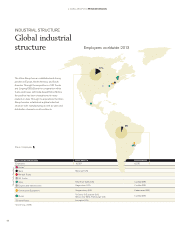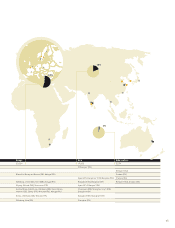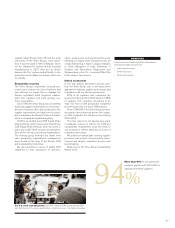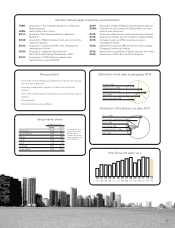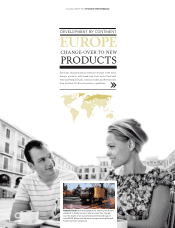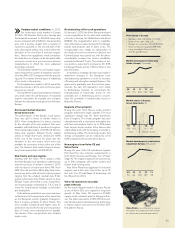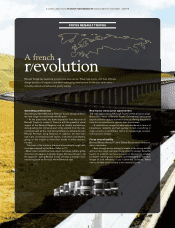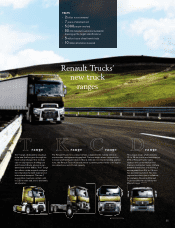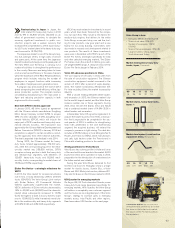Volvo 2013 Annual Report Download - page 57
Download and view the complete annual report
Please find page 57 of the 2013 Volvo annual report below. You can navigate through the pages in the report by either clicking on the pages listed below, or by using the keyword search tool below to find specific information within the annual report.
Varying market conditions. In 2013,
the heavy-duty truck market in Europe
30 (EU’s 28 Member States plus Norway and
Switzerland) increased to 240,200 heavy-duty
trucks compared with 221,800 in the preceding
year, with a positive impact from a number of
customers, primarily in the second half of the
year, choosing to prebuy new trucks before the
transition to the new Euro 6 emission regula-
tions. These new regulations entail considera-
ble reductions in nitrogen oxide and particulate
emissions, as well as a price increase by truck
manufacturers to offset the more advanced
technology required.
The European market for construction equip-
ment, measured in number of machines sold, de -
clined by 4% in 2013 compared with the preced-
ing year. The market showed signs of stabilizing
at low levels in the autumn.
The European bus market in 2013 was at the
same low level as in 2012, with continuous price
pressure as a result.
The market for leisure boat engines remained
very weak while the performance of industrial
en gines was better, for example, due to higher
demand for diesel-powered gensets in Western
Europe.
Decreased market shares in
heavy-duty trucks
The performance of the Group’s truck opera-
tions was split in terms of market shares in
2013. Volvo strengthened its shares, boosted
by the strength of its new products that were
available with both Euro 5 and Euro 6 engines.
Volvo held a market share of 16.3% (15.6) in the
heavy-duty segment. Renault Trucks’ market
shares in heavy-duty trucks declined to 8.0%
(10.1), one of the reasons for which was the
transition to the new trucks, which were only
available for customers to test at the end of the
year. The Group’s total market share in heavy-
duty trucks amounted to 24.3% (25.7).
New trucks and new engines
Starting with the Volvo FH in autumn 2012,
theVolvo Group’s truck operations underwent an
ex tensive process of product renewal in 2013,
with the launch of brand-new Volvo FM, Volvo
FMX, Volvo FL and Volvo FE. In May, Volvo intro-
duced new trucks with a Euro 6 engine program
ranging from the smallest medium-duty 5-liter
engine to the heavy-duty 13-liter version. In June,
Renault Trucks presented a new, comprehen-
sive truck program comprising its T, K, C and D
series for long-distance haulage, construction
and distribution.
In the autumn production was more and more
switched over to the new trucks at the same time
as the European system gradually changed to
Euro 6 engines, primarily for Volvo Trucks. This
led to greater complexity and higher costs for
production since both the old and new genera-
tions of trucks were manufactured in parallel.
The launch of the new products also entailed
higher costs.
Restructuring of the truck operations
On January 1, 2013, the Volvo Group introduced
a new organization for its sales and marketing
of trucks in Europe, the Middle East and Africa
(EMEA). The reorganization aims to capitalize
more effectively on opportunities for the Group’s
brands and products and to lower costs. The
reorganization also entails an optimization of
the dealer and service networks in Eastern and
Central Europe was carried out, with the aim to
considerably increase the service availability,
primarily for Renault Trucks. The number of ser-
vice points is expected to increase by 30–40%
for Renault Trucks and by 10% for Volvo in this
part of Europe.
In October, a strategic decision was made to
implement changes in the European truck
manufacturing operations in order to increase
effi ciency and strengthen competitiveness. The
goals are to gradually, over the next two years,
relocate the cab trim operations from Umeå
to Gothenburg, Sweden, to concentrate the
manufacturing of heavy-duty trucks to one
assembly line in Gothenburg and to concen-
trate the assembly of medium-duty trucks to
Blainville, France.
Upgrade of bus program
During the year, Volvo Buses’ entire product
program underwent a major upgrade. The most
signifi cant change was the three brand-new
Euro 6 engines. The model program was also
strengthened with a new hybrid articulated bus
with fuel consumption that is up to 30% lower
than current diesel models. Volvo Buses also
started fi eld tests with its fi rst plug-in hybrids in
Gothenburg in May. The technology means that
energy consumption can be reduced by a full
60% compared with current diesel buses.
New engines from Volvo CE and
Volvo Penta
During the year, Volvo CE introduced engines
that meet the new emission requirements in
both North America and Europe, Tier 4 Final/
Stage IV. The engines improve fuel economy by
up to 5% compared with earlier models and
reduce total running costs.
Also Volvo Penta has upgraded its industrial
engines, and a full series from 5 liter up to 16
liter with Tier 4 Final/Stage IV technology will
be offered from 2014.
Volvo CE opened an excavator
plant in Russia
As the second largest market in Europe, Russia
is one of Volvo CE’s core regions for long-term
growth. In May, Volvo CE opened a 20,660
square meter excavator plant in Kaluga in Rus-
sia. The plant represents a SEK 350 M invest-
ment and has been developed using technology
to reduce carbon emissions. It is the Volvo CE’s
fi rst plant in Russia.
Volvo Group in Europe
• Net sales: SEK 105,320 M (111,606)
• Share of net sales: 39% (37)
• Number of employees: 52,334 (53,434)
• Share of Group employees: 55% (56)
• Largest markets: France, the UK,
Sweden and Germany.
1312111009
240222242179165
Market development, heavy-duty
trucks, Europe, Thousands
13121312
8.010.116.315.6
Volvo Renault Trucks
Market shares in Europe,
heavy-duty trucks, %
1312111009
1181221259476
Market development, construction
equipment, Europe, Thousands
Volvo Penta is a world-leading supplier
of engines and complete power systems
for marine and industrial applications.
Vol
vo
Pen
ta
is
aw
orl
d-l
ead
ing
su
ppl
ie
53



